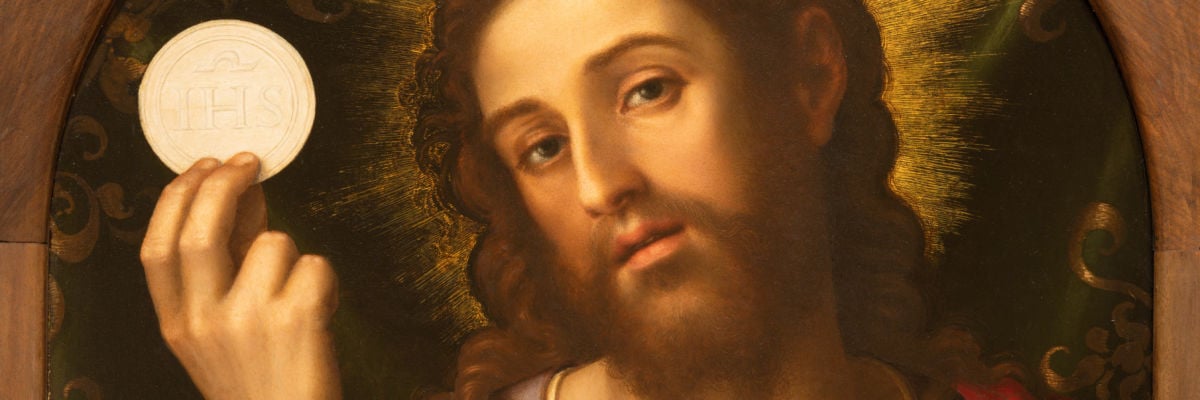
The Catholic doctrine of transubstantiation states that the bread and wine, at the moment of consecration during Holy Mass, actually become the body and blood of Jesus Christ. The change, however, is not detectable by the senses. This has led some Christians to question whether it is true. In order to understand what the doctrine of transubstantiation teaches, and why so many arguments against it are misleading, we need to understand the philosophy behind the doctrine.
About 350 years before Jesus’s incarnation, Aristotle offered a philosophical explanation of change that would later be used by St. Thomas Aquinas to explain the Eucharist. Aristotle said that there are two kinds of change: substantial and accidental. Now, don’t confuse either of these terms with how they are used today! In philosophy, “substance” refers to what a thing is at its core, while “accidents” are modifications of that substance.
For example, people at the beach remain human when they go home because humanity is their substance, but their location is just an accident. And if that person’s skin turns red from being at the beach too long, that is accidental change. Skin color is not determined by the substance of humanity, because it is a difference among humans. Thus, to change skin color is not to go from being human to being non-human.
Substantial change means something is no longer what it was before. The most common example of this is that when a living thing dies, it is no longer that thing, but merely a deteriorating combination of the physical features that composed it, as when a cow dies and its parts are used for various purposes. Although things often undergo accidental and substantial change at the same time, it doesn’t have to happen that way. A thing may undergo accidental change without substantial change (a skinny dog can grow into a fat dog), and a thing might also undergo substantial change without immediately noticeable accidental change (as when a sleeping cow dies). There is more to the distinction between substantial and accidental change, but this is enough to get us started.
Transubstantiation is an English term based on the Latin words for the process of change in substance, as transportation is for the process of changing location. In Catholic theology, transubstantiation indicates the change that the elements of Communion undergo when they change from bread and wine into the body and blood of Jesus Christ. This change is utterly unique because this substantial change occurs without any accidental change. With the exception of some remarkable Eucharistic miracles, transubstantiation does not result in a change that is empirically detectable or scientifically provable. The doctrine is thus not believed because of any perceived change, but it is believed to be the best explanation for biblical statements that identify the Communion meal with Jesus’ body and blood (Luke 22:19-20; John 6:53-58; 1 Cor. 11:26-27), as well as the testimony of the historic Church.
Those complaining that the bread and wine do not appear to be flesh and blood, then, are not only expressing common sense, but also affirming the teaching of the Church. A skeptic who tries to disprove transubstantiation scientifically on these grounds, however, would be wasting his time, for there is no physical means to prove or disprove such a change. It would be like trying to mathematically prove which perfume smells better.
Furthermore, Catholics are prepared for their First Holy Communion precisely by being taught what the Eucharist truly is (see the Code of Canon Law 913). So, because the Church explains this miracle, it is not a case of God deluding or deceiving believers, as some have argued. For example, Evangelical apologist Norman Geisler complains that transubstantiation “undermines belief in the resurrection because if our senses are deceiving us about the consecrated host, then how do we know they are not deceiving us about the resurrection appearances of Christ?” If transubstantiation is true, however, then our senses are not deceiving us at all. Rather, they are correctly delivering sensation of the accidents of bread and wine. St. Paul’s requirement is that the body and blood be discerned, not sensed (1 Cor. 11:29).
Christians who fail to discern Jesus’ body and blood in the Eucharist have been tragically misled. All Christians believe in an omnipotent God who could perform the miracle of transubstantiation if he willed it. That same God inspired passages from Scripture that (if taken literally) teach that the Communion meal is truly Jesus’ body and blood. That God who inspired Scripture built a Church based on the Eucharist, and that Church taught the dogma for 1,200 years before Aquinas explained it philosophically, and it remained virtually unquestioned until the sixteenth century, during the Reformation. Denial of the dogma of transubstantiation is contrary to both Sacred Scripture and Sacred Tradition.
As Thomas Aquinas wrote,
does any unbeliever profess that the changing of bread and wine into the body and blood of the Lord is impossible? Then let him consider God’s omnipotence. Admit that nature can transform one thing into another, then with greater reason should you admit that God’s almighty power, which brings into existence the whole substance of things, can work not as nature does, by changing forms in the same matter, but by changing one whole thing into another whole thing (Concerning Reasons of Faith 8).
What is perhaps an even larger problem, though, is that arguments against transubstantiation based on appearance seem to work equally well against the incarnation of the Son of God. Being made in the form of a man (Phil. 2:5-8), Jesus’ divinity could not be detected by any empirical means, and one could say his dual nature is even harder to believe than a transubstantiated Communion meal! Jesus was clearly a human being with all the limitations of humanity, yet Christianity teaches that he was also God, the second person of the Holy Trinity. These are not just big differences—without the faith as authoritatively taught by the Church since its origin, they can appear to be logically contradictory.
Which is more difficult to believe: that one finite, material thing can be changed into another thing spiritually while retaining its physical properties, or that apparently contradictory properties can coexist in one person? If one cannot accept transubstantiation simply because it seems counterintuitive or implausible, it is difficult to see how one could remain a Christian at all.



